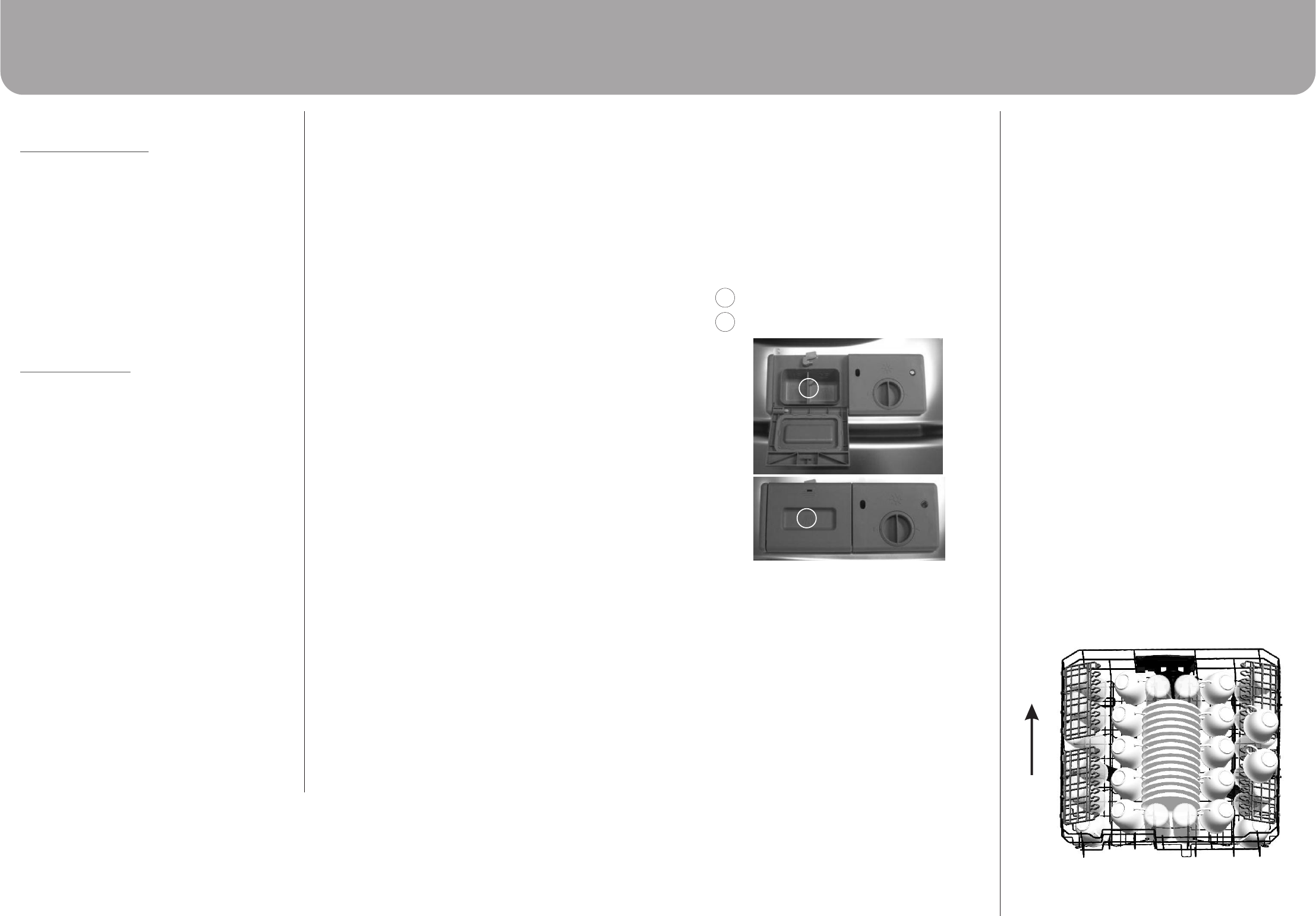
Using Your Dishwasher
Page 11Page 14
B
A
Location of main wash cycle detergent.
Location of pre-wash cycle detergent.
Please observe the manufacturers dosing and
storage recommendations as stated on the detergent
packaging.
Close the lid and press until it locks in place.
If the dishes are heavily soiled, place an additional
detergent dose in the pre-wash detergent chamber.
This detergent will take effect during the pre-wash
phase.
NOTE: See information about the amount of
detergent for the single programmes on page 15.
Please be aware, that according to the level soiling
and the specific hardness of water differences are
possible.
P l e a s e o b s e r v e t h e m a n u f a c t u r e r ' s
recommendations on the detergent packaging.
A
B
Using Your Dishwasher
Suitability of items for use in your Dishwasher
Ÿ
Ÿ
Ÿ
Ÿ
Ÿ
Ÿ
Ÿ
Ÿ
Ÿ
NOT SUITABLE FOR USE
Cutlery with wooden, horn china or m o t h e r - o f -
pearl handles.
Plastic items that are not heat resistant.
Older cutlery with glued parts that are not
temperature resistant.
Bonded cutlery items or dishes.
Pewter or copper items.
Crystal glass.
Steel items subject to rusting.
Wooden platters.
Items made from synthetic fibres.
LIMITED SUITABILITY
Some types of glasses can become dull after a
Ÿ
large number of washes.
Silver and aluminum parts have a tendency to
Ÿ
discolour during washing.
Glazed patterns may fade if machine washed
Ÿ
frequently.
NOTE:
Do not put in items that are dirty with cigarette ash,
Ÿ
candle wax, lacquer or paint.
If you buy new dishes please make sure that they
Ÿ
are suitable for dishwashers.
Please do not overload your dishwasher. Do not
Ÿ
use dishes that are not suitable for dishwashers.
This is important for good results and for
reasonable energy consumption.
Before loading the dishes, you should:
Remove large food particles.
Ÿ
Soften remnants of burnt food in pans.
Ÿ
When loading the dishes and cutlery, please note:
Dishes and cutlery must not impede the rotation of
Ÿ
the spray arms.
Load hollow items such as cups, glasses, pans etc.
Ÿ
with the opening downwards so that water cannot
collect in the container or a deep base.
Dishes and items of cutlery must not lie inside one
Ÿ
another, or cover each other.
To avoid damage to glasses, they must not touch.
Ÿ
Load large items which are most difficult to clean
Ÿ
into the lower rack.
The upper rack is designed to hold more delicate
Ÿ
and lighter dishware such as glasses, coffee and
tea cups.
Long bladed knives stored in an upright position are
a potential hazard!
Long and/or sharp items of cutlery such as carving
knives must be positioned horizontally in the upper
basket.
Damage to glassware and other dishes
Possible Causes
Type of glass or manufacturing process. Chemical
Ÿ
composition of detergent.
Water temperature and duration of dishwasher
Ÿ
programme.
Suggested remedy:
Use glassware or porcelain dishes that have been
Ÿ
marked dishwasher-proof by the manufacturer
Use a mild detergent that is described as kind of
Ÿ
dishes If necessary, seek further information from
detergent manufacturers.
Select a programme with as low a temperature.
Ÿ
To prevent damage, take glass and cutlery out of
Ÿ
the dishwasher as soon as possible after the
programme has ended. as possible after the
programme has ended.
ATTENTION!
Ÿ
Ÿ
WARNING! Dishwasher detergent is poisonous! Take
care to keep it out of reach of children.
Proper Use of Detergent
Only use detergent specifically made for the use in
Ÿ
dishwashers. Keep your detergent fresh and dry.
Don't put powdered detergent into the dispenser
Ÿ
until you're ready to wash dishes.
Fill the detergent dispenser with detergent. The
marking indicates the dosing levels, as shown below:
LOADING THE DISHWASHER BASKET
For best performance of the dishwasher, follow these
loading guidelines. Features and appearance of
baskets and cutlery baskets may vary from your model.
Attention before or after Loading the Dishwasher
Baskets.
Scrape off any large food particles. Soften remnants of
burnt food in pans.
It is not necessary to rinse the dishes under running
water. Place objects in the dishwasher in following way:
1. Items such as cups, glasses, pots/pans, etc. are
faced downwards.
2. Curved items, or ones with recesses, should be
loaded aslant so that water can run off.
3. All utensils are stacked securely and can not tip
over.
4. All utensils are placed in the way that the spray
arms can rotate freely during washing.
Very small items should not be washed in the
dishwasher as they could easily fall out of the baskets.
Removing the Dishes
To prevent water dripping from the upper basket into
the lower basket, we recommend that you empty the
lower basket first and then the upper basket.
Loading the Upper Basket
The upper basket is designed to hold more delicate
and lighter dishware such as glasses, coffee and tea
cup and saucers, as well as plates, small bowls and
shallow pans (as long as they are not too dirty).
Position the dishes and cookware so that they do not
get moved by the spray of water.
IN
1 - Cups 2 - Saucers 3 - Glasses
1
1
1
1
1
3
3
3
2
3
1
1














